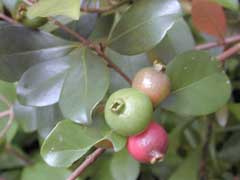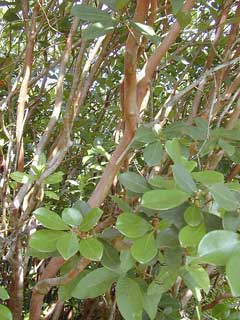 |
|
http://www.hear.org/starr/ |
 |
| http://www.hear.org/starr/ |
Translate this page:
Summary
Physical Characteristics

 Psidium cattleianum is an evergreen Shrub growing to 6 m (19ft 8in).
Psidium cattleianum is an evergreen Shrub growing to 6 m (19ft 8in).
See above for USDA hardiness. It is hardy to UK zone 10 and is frost tender. It is in leaf all year, in flower in May. The species is hermaphrodite (has both male and female organs).
Suitable for: light (sandy) and medium (loamy) soils, prefers well-drained soil and can grow in nutritionally poor soil. Suitable pH: mildly acid, neutral and basic (mildly alkaline) soils and can grow in very acid soils.
It cannot grow in the shade. It prefers dry or moist soil.
UK Hardiness Map
US Hardiness Map
Synonyms
P. cattleianum. Salisb.
Plant Habitats
Woodland Garden Sunny Edge; Hedge; South Wall. By. West Wall. By.
Edible Uses
Edible Parts: Fruit
Edible Uses: Drink
Fruit - raw or cooked[1, 3, 61]. The fruit can be used in jellies, jams, custards, drinks etc[183]. Sweet and aromatic. The flavour is more pronounced than that of the yellow strawberry guava but lacks the muskiness of the common guava[183]. The fruit has an agreeable acid-sweet flavour and is good when eaten raw[2, 46], though it can also be used in preserves[177]. The fruit is about 4cm in diameter[200]. Fruit and processed products are traded locally throughout the tropics and subtropics and although the economic importance of P. cattleianum remains low, it can become significant when it is cultivated (e.g. on Réunion). Its cultivation has been tested in Spain (Salinero Corral and Aguin Casal, 1993, 1996) and in Réunion (Normand, 1994, 2002b) where it is now a profitable crop. In contrast to the fruit from P. guajava, P. cattleianum fruit are not rich in vitamin C, with only 11-50 mg per 100 g [1-8].
References More on Edible Uses
Medicinal Uses
Plants For A Future can not take any responsibility for any adverse effects from the use of plants. Always seek advice from a professional before using a plant medicinally.
Antibacterial Antidiarrhoeal Astringent
Leaves contain compounds active against antibiotic-resistant strains of Gram-positive bacteria which are important human pathogens. They contain flavonoids, saponins, tannins, and essential oils, mainly b-caryophyllene. Fruit and leaves are used in traditional medicine against haemorrhage, diarrhoea and colic. Leaves are a source of essential oils produced after distillation [1-8].
References More on Medicinal Uses
The Bookshop: Edible Plant Books
Our Latest books on Perennial Plants For Food Forests and Permaculture Gardens in paperback or digital formats.

Edible Tropical Plants
Food Forest Plants for Hotter Conditions: 250+ Plants For Tropical Food Forests & Permaculture Gardens.
More

Edible Temperate Plants
Plants for Your Food Forest: 500 Plants for Temperate Food Forests & Permaculture Gardens.
More

More Books
PFAF have eight books available in paperback and digital formats. Browse the shop for more information.
Shop Now
Other Uses
Essential Fodder Hedge Hedge Shelterbelt
Grown as a fruiting hedge in warm temperate climates[200]. P. cattleianum is grown as an ornamental (garden tree or hedge tree) in the tropics and sub-tropics because of its slow growth, its pleasant dark green and shiny foliage and its tasty fruit. Fuel. Essential Oil [1-8]. Poultry forage. Windbreak.
Special Uses
Hedge Hedge
References More on Other Uses
Cultivation details
Requires a well-drained sandy loam with leaf mold [1]. Requires cool greenhouse treatment in Britain[1]. Tolerates short-lived light frosts[200] and cool summers[3] so it might succeed outdoors in the mildest areas of the country. Hardier to cold than the common guava. Dislikes much humidity. Sometimes cultivated for its edible fruit, there are some named varieties[183]. Special soil tolerances: infertile, shallow [1-8].
References Carbon Farming Information and Carbon Sequestration Information
Temperature Converter
Type a value in the Celsius field to convert the value to Fahrenheit:
Fahrenheit:
The PFAF Bookshop
Plants For A Future have a number of books available in paperback and digital form. Book titles include Edible Plants, Edible Perennials, Edible Trees,Edible Shrubs, Woodland Gardening, and Temperate Food Forest Plants. Our new book is Food Forest Plants For Hotter Conditions (Tropical and Sub-Tropical).
Shop Now
Plant Propagation
Seed - sow spring in a warm greenhouse. When large enough to handle, prick out the seedlings into individual pots and grow them on in the greenhouse for at least their first winter. If trying the plants outdoors, plant them out in the summer and give them some protection from winter cold for at least their first two winters. Cuttings of half-ripe wood, July/August in a frame.
Other Names
If available other names are mentioned here
Strawberry Guava, Thai Guava, Cattley Guava, Cherry Guava, Chinese Guava, Purple Guava, Kuahpa, Bella seebai, Cattley guava, Konda jamipandu, Malam perakka, Mpera-ngombe, Mpera, Pahadi pijuli, Pahari payara, Porpay, Purple guava, Purple strawberry guava, Quwawa ni vavalagi, Red Strawberry guava, Seemai koyya,
Native Range
Coming Soon
Weed Potential
Right plant wrong place. We are currently updating this section.
Please note that a plant may be invasive in one area but may not in your area so it's worth checking.
P. cattleianum is naturalized in many tropical and subtropical countries after introduction as an ornamental or a fruit tree. It has invaded humid areas such as rainforests on tropical islands especially in the Pacific and Indian Oceans where it displaces native species and threatens their survival. It thrives in a large range of ecological conditions and reproduces efficiently by seeds and suckers [1-8].
Conservation Status
IUCN Red List of Threatened Plants Status : This taxon has not yet been assessed

Growth: S = slow M = medium F = fast. Soil: L = light (sandy) M = medium H = heavy (clay). pH: A = acid N = neutral B = basic (alkaline). Shade: F = full shade S = semi-shade N = no shade. Moisture: D = dry M = Moist We = wet Wa = water.
Now available:
Food Forest Plants for Mediterranean Conditions
350+ Perennial Plants For Mediterranean and Drier Food Forests and Permaculture Gardens.
[Paperback and eBook]
This is the third in Plants For A Future's series of plant guides for food forests tailored to
specific climate zones. Following volumes on temperate and tropical ecosystems, this book focuses
on species suited to Mediterranean conditions—regions with hot, dry summers and cool, wet winters,
often facing the added challenge of climate change.
Read More
Expert comment
Author
Sabine.
Botanical References
200
Links / References
For a list of references used on this page please go here
A special thanks to Ken Fern for some of the information used on this page.
Readers comment
© 2010, Plants For A Future. Plants For A Future is a charitable company limited by guarantee, registered in England and Wales. Charity No. 1057719, Company No. 3204567.